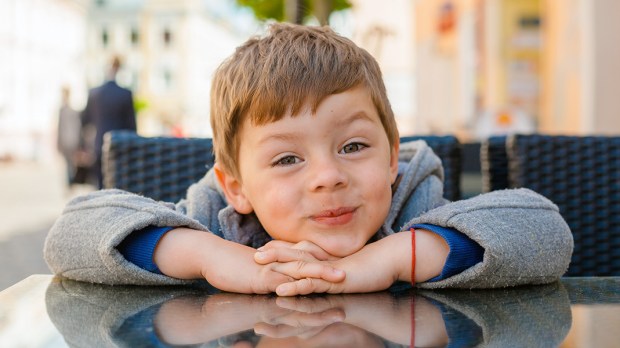Let’s face it: we don’t give birth to blank pages. Barely out of their mother’s womb, our children already have their own temperaments. We don’t give birth to clones either. The anger of our eldest rarely resembles that of the youngest, the emotionality of our third is different than our fourth. Our children are different from the moment they are born. “They come into the world with a temperament they have inherited and which, at the same time, is their own,” confirms Marie-Paule Mordefroid, a specialist in personality types. In large families, parents quickly notice these differences from one child to the next.
This innate part of their character determines, to a large extent, a child’s behaviors and reactions. Why is Peter daydreaming with his books all day long and Juliette hopping from one activity to the next, when they were raised the same way? Knowing as parents how to recognize our child’s temperament can be a precious help in our educational mission. In this way, we can better understand and communicate with them, adapt our style of authority, and resolve conflicts, which, in sum, “allows parents to adapt the education they give each child.”
The eight combinations of temperaments
Do not expect a magic recipe, however. Knowing that your child is non-active, emotional, and a secondary responder will not give you step-by-step instructions on how to better educate them. Parents are the guides of their children’s education, through who they are and how they themselves were raised. Understanding a child’s temperament provides a proposed key to reading them, not an instruction manual. Tracking down this temperament requires time, patience, and a good dose of observation. We cannot draw the inner map of our offspring in a week, after having given them a battery of tests. This research requires the use of a reading grid. That’s where things get tricky. Since antiquity, several classifications have been elaborated, none of them unanimously. We have chosen three of them: Le Senne’s method, the Enneagram, and the five senses.
The founder of French characterology, psychologist René Le Senne, identified three factors that make up our temperament, namely: emotionality, activity and impact. Emotionality is the ability to react emotionally to an event. Emotional people are distinguished from non-emotional people by the intensity of their manifestations or actions. The former will be very demonstrative, while the latter could be resolutely defined as phlegmatic. Activity, on the other hand, takes into account the reaction to an obstacle and the ease with which one can act. The active person is one who is action-oriented, who sets goals and seeks to achieve them. On the other hand, the non-active is turned inward and easily gives up acting when an obstacle is encountered. They find it difficult to take action. They need accompaniment or support to initiate action. Like those children who can’t get dressed on their own without Mom or Dad around.
Impact, finally, defines the way in which impressions are received, either by an immediate and brief reaction (primacy), or by a delayed and prolonged, lasting reaction (secondarity). The primaries will more likely be go-getters, ready to modify the initial program. The secondaries will need to be forewarned, and changes anticipated. Keeping their word is important to them.
According to the combinations that we cannot fully develop here, there are eight temperaments: nervous, sentimental, angry, passionate, sanguine, phlegmatic, amorphous, apathetic.
The three centers of energy
Very much in vogue, the Enneagram can help you bring into focus your child’s temperament. It is not advisable to “typecast” the child among the nine bases proposed by this method. However, the three energy centers of the enneagram can be used to highlight their dominant profile, without boxing them into a simple classification: the instinctive center (the guts), the emotional center (the heart), and the mental center (the head).
In the instinctive, the action does not pass through the filter of the heart or reason. They just go ahead and try things without always thinking it through. And when they don’t succeed, they tend to get angry. Emotional people are driven by emotions, relationships and recognition. Very dependent on others, they are very happy, altruistic and sensitive. As for the cerebral ones, they are in permanent representation and discernment, reflecting on everything and making links between everything. Independent and autonomous, they can encounter difficulties in taking action.
Marielle Bradel, in L’Ennéagramme, un chemin de vie [The Enneagram, a life path], describes how three children can behave differently in the same situation: the year-end festival in kindergarten. All the parents are in the room. The children walk onto the stage. Jeremy enters with a determined step and, leaving the teacher’s instructions behind, stands in the middle: it is impossible to get him to change places. He is there, he stays there. It’s an instinctive move. Further on, Emily enters timidly, immersed in her thoughts, and stays where she is told to. While waiting for the festival to begin, she goes over the poem she is going to recite in her head. Her center is the mind. Then we have Elise, who entered with a smile on her face, her eyes fixed on the room: Is Grandma there? She had promised to come. Elise does not see her, tears forming at the edge of her eyes. Suddenly, she sees her. The smile comes back, she waves to her, sends her kisses … without paying attention to the teacher who tries to bring her back to her place. Pure emotion!
Tell me what sense you use, I’ll tell you who you are
The different learning styles will also help us discern how our children perceive and receive outside information. While we receive everything through all five of our senses, we have one or two privileged ones.
Hearing people will need us to explain things further to them. They need to understand. Speech, the voice, the stories told, will be appreciated channels for them. Visually-oriented children will find it easier to grasp concepts with images, pictograms, and examples that will allow them to create mental images for themselves. The kinesthetic learners learn by experience, through their hands but also through their bodies. They will need us to do concrete exercises with them, role-playing, etc.
It is up to us as parents to explore our children’s personalities further and use this info as we raise and educate them.
Antoine Pasquier

Read more:
What’s your “stress personality”?

